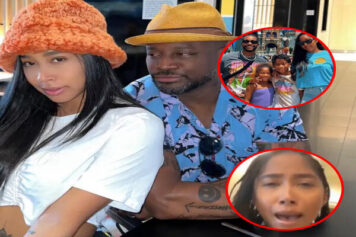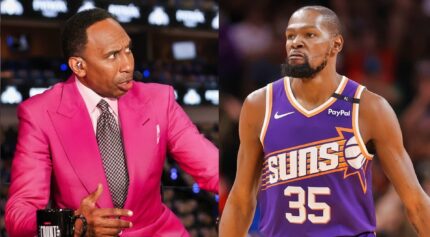With the Donald Sterling circus growing exponentially in scope and absurdity over the last few days thanks to the Los Angeles Clippers owner’s acidic comments about Lakers legend Magic Johnson in his recent interview with CNN’s Anderson Cooper, this situation promises to hold a special place of prominence in the national dialogue in the weeks and months ahead.
The Sterling debacle and specter of his ownership will undoubtedly hover around the remainder of these fantastic playoffs, the upcoming coronation of Jabari Parker, Joel Embiid and Andrew Wiggins at June’s draft and the various NBA summer leagues.
No matter how thrilling and beautiful this year’s Finals performances by Tony Parker, Russell Westbrook, Blake Griffin, Kevin Durant, Chris Paul or LeBron might be, Sterling’s shadow will be like Chewbacca’s legs on Dorothy Dandridge, a hideous eyesore to an otherwise stunning display.
Sterling seems utterly inebriated at the sound of his own voice, despite the fact that his words have powered an irreversible vortex of self-destruction.
And yet, slowly rising back to the surface from the muck of his racist diatribes and personal attacks is a name that many people dismissed some time ago, the beleaguered former General Manager of the franchise, Elgin Baylor.
Not sure if many people were paying attention a few years back, but if they were, they’d have noticed that every time Kobe Bryant binged on buckets and etched his name into the Lakers record books, his accomplishments were always prefaced by, “…The previous mark was held by Elgin Baylor.”
Until he entered the NBA in 1958, the terms ‘Levitation’ and ‘Hang-Time’ were not in the lexicon of pro basketball. Baylor was the league’s first true aerial artist, capable of defying gravity while waiting for the shot that he wanted. He was the precursor to Dr. J and Air Jordan.
Muscular and strong, yet sleek and smooth, Baylor brought the astounding force of athleticism to the personality of the professional product. He made the spectacular look routine and was impervious to any defense designed to stop him. He singlehandedly brought the essence of the game’s unexplored vertical chamber to what was previously a below-the-rim game.
Without exaggeration, Elgin Baylor was at least a quarter-century ahead of his time. Had he come along in the 1980s, at the merge of the ESPN and sports marketing revolutions, we would have been sporting Air Elgins, eating Elgin Flakes for breakfast, buying cars, underwear, sports drinks and fast food burgers because he went on television and told us to.
But Baylor came of age in a different era, when he couldn’t actually play at certain places because of the searing grips of segregation in his hometown of Washington, DC. But he honed his futuristic, George Jetson-game on the asphalt of the nation’s capitol with the city’s other talented black athletes that were denied access to some parks and facilities because of the color of their skin.
He dropped out of Phelps Vocational HS to work in a furniture store before returning to Spingarn High School, one of the city’s five black schools. Baylor was the first African-American named to the area’s All-Metro team, a glaring indictment on the racist sensibilities that ignored all of those that came before him.
And yet, because of the country’s ignorant leanings and Baylor’s supposed academic deficiencies, no college basketball powers offered him a scholarship. He eventually found his way to the College of Idaho to play football. But he never wore another pair of cleats after the school’s hoops coach saw him toying with people during pick-up games in the gym.
After one year in Idaho, he transferred to Seattle University. The national buzz started generating after he scored 40 points in his first game there. It escalated when he went on to average 30 points and 20 rebounds a game during the 1956-1957 season. Prior to his arrival, the program was as inconsequential as Rockwell after he dropped "Somebody's Watching Me".
During his stay in Seattle, they shot up the charts like the Jackson 5 at Motown.
At the conclusion of the ‘57-’58 season, Seattle University was playing in the NCAA championship game. Despite losing to the University of Kentucky, Baylor was named the tournament’s Most Outstanding Player, although he'd been playing with broken ribs.
Magic, Kobe, Wilt, Jerry West and Kareem might be the first that come to mind when you think about the legendary names in the Los Angeles Lakers pantheon. But most people fail to recognize that had it not been for Elgin Baylor, the franchise might not even exist today in its current incarnation.
Baylor singlehandedly saved the struggling franchise when it was located in Minneapolis. Without the revenue that he generated, the Lakers could have never made the George and Weezie Jefferson move on up to that deluxe apartment in the Hollywood sky.
“I would have been out of business,” then-Laker owner Bob Short told the L.A. Times in 1971. “The club would have gone bankrupt.”
The year prior to his arrival, the Lakers finished with a record of 19-53, a far cry from the glory days of its first franchise cornerstone, George Mikan.
As a rookie in 1958-1959, Baylor averaged 25 points and 15 rebounds per game. Before Spike Lee crowned the term “Double-Nickel”, he scored 55 in a game during his first NBA season. The Lakers made a surprising run to the Finals that year, losing to the Boston Celtics. It was the start of what became the greatest rivalry in professional sports.
In November of 1960, he scored 71 points and snatched 25 rebounds in a single game against the New York Knicks. In December of 1961, he gave Wilt Chamberlain and the Philadelphia Warriors 63 points and 31 rebounds in a game. 63 and 31!!!
In game 5 of the 1961-1962 NBA Finals, Baylor scored 61 points and ripped down 22 rebounds against the Celtics’ phenomenal duo of Satch Sanders and Bill Rusell, two of the games’ greatest defenders ever. No player has since eclipsed that record of points scored in a Finals game.
Only one player in NBA history has scored more in a playoff game. That was Air Jordan’s amazing performance against the Celtics in 1986, when Larry Bird referred to him as, “God disguised as Michael Jordan." It is the only feat that has surpassed Elgin Baylor’s – but MJ needed every bit of those two overtimes to get his 63 points.
His former teammate Tommy Hawkins once told the San Francisco Examiner, “Pound for pound, no one was ever as great as Elgin Baylor. Elgin certainly didn't jump as high as Michael Jordan. But he had the greatest variety of shots of anyone. He would take it in and hang and shoot from all these angles. Put spin on the ball. Elgin had incredible strength. He could post up Bill Russell. He could pass like Magic and dribble with the best guards in the league.”
With the franchise’s relocation to Los Angeles, Baylor was also solely responsible for the NBA’s growth and acceptance outside of its East Coast origins.
His greatness gets lost in the sauce because he played before the media explosion. Despite taking the Lakers to the Finals eight times, he never won an NBA title and had his best years when Wilt Chamberlain, Oscar Robertson and Bill Russell also had theirs.
When the Clippers were the laughingstock of the league, Baylor was the face of the franchise as its General Manager. People cast aside his assertions that he was hamstrung by Donald Sterling’s terrible basketball business acumen.
The running joke was that there were three things in life that were certain: death, taxes and Elgin Baylor representing the Clippers at the NBA’s Draft Lottery.
But he let us know, long ago, that the racism spewing from the owner’s suite was severe and toxic, before most people seemed to give it any credence.
When Baylor sued Sterling for wrongful termination on the grounds of age and race discrimination, a suit that was eventually unsuccessful, many saw it as the act of an inept and desperate man trying to hold on to his job, in a game that had passed him by.
Today, we see, with a little more clarity, who the inept and desperate man really is, as Sterling currently tries to hold onto his team, in a league and society that passed his plantation-mentality by long ago.
But step aside from the shipwreck for a moment and remember to keep in mind, next year, when Kobe comes back to break another Lakers record, that it was Elgin Baylor’s skills and impact that sketched today’s NBA blueprint.
And we must thank him as well for being the first person to announce to the world, years ago, that Donald Sterling was an idiot.



